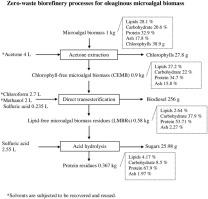当前位置:
X-MOL 学术
›
Process Biochem.
›
论文详情
Our official English website, www.x-mol.net, welcomes your
feedback! (Note: you will need to create a separate account there.)
Zero-waste Biorefinery of Oleaginous Microalgae as Promising Sources of Biofuels and Biochemicals through Direct Transesterification and Acid Hydrolysis
Process Biochemistry ( IF 3.7 ) Pub Date : 2020-08-01 , DOI: 10.1016/j.procbio.2020.02.011 Yohanis Irenius Mandik , Benjamas Cheirsilp , Sirasit Srinuanpan , Wageeporn Maneechote , Piyarat Boonsawang , Poonsuk Prasertsan , Sarote Sirisansaneeyakul
Process Biochemistry ( IF 3.7 ) Pub Date : 2020-08-01 , DOI: 10.1016/j.procbio.2020.02.011 Yohanis Irenius Mandik , Benjamas Cheirsilp , Sirasit Srinuanpan , Wageeporn Maneechote , Piyarat Boonsawang , Poonsuk Prasertsan , Sarote Sirisansaneeyakul

|
Abstract Oleaginous microalgae are considered as promising sources of biofuels and biochemicals due to their high lipid content and other high-value components such as pigments, carbohydrate and protein. This study aimed to develop an efficient biorefinery process for utilizing all of the components in oleaginous microalgae. Acetone extraction was used to recover microalgal pigments prior to processes for the other products. Microalgal lipids were converted into biodiesel (fatty acid methyl ester, FAME) through a conventional two-step process of lipid extraction followed by transesterification, and alternatively a one-step direct transesterification. The comparable FAME yields from both methods indicate the effectiveness of direct transesterification. The operating parameters for direct transesterification were optimized through response surface methodology (RSM). The maximum FAME yield of 256 g/kg-biomass was achieved when using chloroform:methanol as co-solvents for extracting and reacting reagents at 1.35:1 volumetric ratio, 70 °C reaction temperature, and 120 min reaction time. The carbohydrate content in lipid-free microalgal biomass residues (LMBRs) was subsequently acid hydrolyzed into sugars under optimized conditions from RSM. The maximum sugar yield obtained was 44.8 g/kg-LMBRs and the protein residues were recovered after hydrolysis. This biorefinery process may contribute greatly to zero-waste industrialization of microalgae based biofuels and biochemicals.
中文翻译:

通过直接酯交换和酸水解将含油微藻零废物生物精炼作为生物燃料和生物化学品的有希望的来源
摘要 含油微藻因其高脂质含量和其他高价值成分(如色素、碳水化合物和蛋白质)而被认为是有前途的生物燃料和生物化学品来源。本研究旨在开发一种有效的生物精炼工艺,以利用含油微藻中的所有成分。在处理其他产品之前,使用丙酮萃取来回收微藻色素。微藻脂质通过脂质提取和酯交换的常规两步过程转化为生物柴油(脂肪酸甲酯,FAME),或者一步直接酯交换。两种方法的可比 FAME 产率表明直接酯交换的有效性。通过响应面方法 (RSM) 优化直接酯交换的操作参数。当使用氯仿:甲醇作为共溶剂以 1.35:1 的体积比、70 °C 的反应温度和 120 分钟的反应时间提取和反应试剂时,FAME 产量达到 256 g/kg-生物质。随后,在 RSM 的优化条件下,无脂微藻生物质残留物 (LMBR) 中的碳水化合物含量被酸水解成糖。获得的最大糖产量为 44.8 g/kg-LMBRs,水解后回收蛋白质残留物。这种生物精炼过程可能对基于微藻的生物燃料和生物化学品的零废物工业化做出巨大贡献。甲醇作为共溶剂,以 1.35:1 的体积比、70 °C 的反应温度和 120 分钟的反应时间提取和反应试剂。随后,在 RSM 的优化条件下,无脂微藻生物质残留物 (LMBR) 中的碳水化合物含量被酸水解成糖。获得的最大糖产量为 44.8 g/kg-LMBRs,水解后回收蛋白质残留物。这种生物精炼过程可能对基于微藻的生物燃料和生物化学品的零废物工业化做出巨大贡献。甲醇作为共溶剂,以 1.35:1 的体积比、70 °C 的反应温度和 120 分钟的反应时间提取和反应试剂。随后,在 RSM 的优化条件下,无脂微藻生物质残留物 (LMBR) 中的碳水化合物含量被酸水解成糖。获得的最大糖产量为 44.8 g/kg-LMBRs,水解后回收蛋白质残留物。这种生物精炼过程可能对基于微藻的生物燃料和生物化学品的零废物工业化做出巨大贡献。水解后回收 8 g/kg-LMBRs 和蛋白质残留物。这种生物精炼过程可能对基于微藻的生物燃料和生物化学品的零废物工业化做出巨大贡献。水解后回收 8 g/kg-LMBRs 和蛋白质残留物。这种生物精炼过程可能对基于微藻的生物燃料和生物化学品的零废物工业化做出巨大贡献。
更新日期:2020-08-01
中文翻译:

通过直接酯交换和酸水解将含油微藻零废物生物精炼作为生物燃料和生物化学品的有希望的来源
摘要 含油微藻因其高脂质含量和其他高价值成分(如色素、碳水化合物和蛋白质)而被认为是有前途的生物燃料和生物化学品来源。本研究旨在开发一种有效的生物精炼工艺,以利用含油微藻中的所有成分。在处理其他产品之前,使用丙酮萃取来回收微藻色素。微藻脂质通过脂质提取和酯交换的常规两步过程转化为生物柴油(脂肪酸甲酯,FAME),或者一步直接酯交换。两种方法的可比 FAME 产率表明直接酯交换的有效性。通过响应面方法 (RSM) 优化直接酯交换的操作参数。当使用氯仿:甲醇作为共溶剂以 1.35:1 的体积比、70 °C 的反应温度和 120 分钟的反应时间提取和反应试剂时,FAME 产量达到 256 g/kg-生物质。随后,在 RSM 的优化条件下,无脂微藻生物质残留物 (LMBR) 中的碳水化合物含量被酸水解成糖。获得的最大糖产量为 44.8 g/kg-LMBRs,水解后回收蛋白质残留物。这种生物精炼过程可能对基于微藻的生物燃料和生物化学品的零废物工业化做出巨大贡献。甲醇作为共溶剂,以 1.35:1 的体积比、70 °C 的反应温度和 120 分钟的反应时间提取和反应试剂。随后,在 RSM 的优化条件下,无脂微藻生物质残留物 (LMBR) 中的碳水化合物含量被酸水解成糖。获得的最大糖产量为 44.8 g/kg-LMBRs,水解后回收蛋白质残留物。这种生物精炼过程可能对基于微藻的生物燃料和生物化学品的零废物工业化做出巨大贡献。甲醇作为共溶剂,以 1.35:1 的体积比、70 °C 的反应温度和 120 分钟的反应时间提取和反应试剂。随后,在 RSM 的优化条件下,无脂微藻生物质残留物 (LMBR) 中的碳水化合物含量被酸水解成糖。获得的最大糖产量为 44.8 g/kg-LMBRs,水解后回收蛋白质残留物。这种生物精炼过程可能对基于微藻的生物燃料和生物化学品的零废物工业化做出巨大贡献。水解后回收 8 g/kg-LMBRs 和蛋白质残留物。这种生物精炼过程可能对基于微藻的生物燃料和生物化学品的零废物工业化做出巨大贡献。水解后回收 8 g/kg-LMBRs 和蛋白质残留物。这种生物精炼过程可能对基于微藻的生物燃料和生物化学品的零废物工业化做出巨大贡献。











































 京公网安备 11010802027423号
京公网安备 11010802027423号